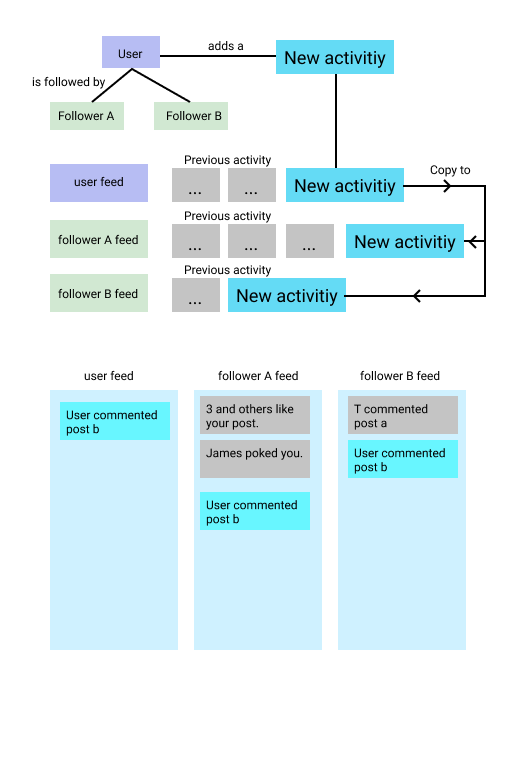@imcyee/superstream v1.0.1
Notice
This library is still in the process of porting/developing from Stream Framework.
Help needed
If you wish to help, PR is always welcome.
Features:
- Activity Feed, eg: facebook feeds
- Notification
Usage
import { Manager, setupRedisConfig, Activity, RegisterManager, setupTask } from 'superstream'
import { GenericContainer } from "testcontainers";
import * as faker from 'faker'
/**
* Extend manager class
* Test class for manager
*/
@RegisterManager()
export class TestManager extends Manager {
// override method to getUserFollowerIds
async getUserFollowerIds() {
return {
HIGH: [
faker.datatype.uuid(),
faker.datatype.uuid(),
faker.datatype.uuid(),
faker.datatype.uuid(),
]
}
}
}
(async () => {
// pull Redis image
const redisContainer = await new GenericContainer("redis:6.2.5")
.withExposedPorts(6379)
.start();
// storage configuration
setupRedisConfig({
host: redisContainer.getHost(),
port: redisContainer.getMappedPort(6379),
})
// task configuration
const setupProps = await setupTask({
host: redisContainer.getHost(),
port: redisContainer.getMappedPort(6379),
})
// after storage and task are successfully started
const managerFeed = new TestManager()
const userId = faker.datatype.uuid()
// create activity
const activity = new Activity({
actor: `user:${faker.datatype.uuid()}`,
verb: faker.random.arrayElement([`cinema:book`, 'themepark:go']),
object: `movie:${faker.datatype.number()}`,
})
await managerFeed.addUserActivity(userId, activity)
// get current user feed
const userFeed = managerFeed.getUserFeed(userId)
const activities = await userFeed.getItem(0, 5)
console.log('activities: ', activities);
// cleanup
return async () => {
await setupProps.shutdown()
await redisContainer.stop()
}
})()How it works

What is has changed from the source?
Field ID:
Stream Framework only support integer ID by default to redis and cassandra.
This port supports ID with string, such as
User:123instead of just123by default.serializationId generator:
Each activity is assigned an Unique ID,
Previously, from stream-framework:
activity.serialization_id = 1373266755000000000042008 1373266755000 activity creation time as epoch with millisecond resolution 0000000000042 activity left padded object_id (10 digits) 008 left padded activity verb id (3 digits)Currently The format is about the same but our id field are not string instead of Int we have to hash it. Hence, our collision fate is now base on the hashing function. What this does is objectId and verbId are both in string hence we have to hash it to generate an integer
// remove all the unhashable key such as :;, // convert any string to int any number and truncate the number to fixed size // using object id and verb // which can be generated repeatedly under any machine const milliseconds = (Number(datetimeToEpoch(this.time) * 1000)) const objectIdPad = hashCodePositive(this.objectId + this.verbId) .toString() .padStart(10, '0') const serializationId = `${milliseconds}${objectIdPad}` // % (milliseconds, this.objectId, this.verb.id)
How can you help
Please see this issue: https://github.com/imcyee/superstream/issues/1
Key concept
Activity
an entity that enclose information, actors, context, objects, etc
Best practice - Saves only IDs instead of the whole object to activity and then re-hydrate it with your own data. So, if you edit your object, you don't have to edit it in feed.
Feed
A feed stores a collection of activities. Each user can have a few feeds, such as notification feed that store all the notification feed.
Serializer
Preparing data to be persisted/loaded, Each type of persistence will require a different serializer. It jobs determine how data is getting translate between api layer and persistence layer.
Storage
Currently supported storages are
- redis
cassandra (Partially)
Which persistence storage to use
Redis: https://redis.io/topics/persistence Pros: easy to work with Cons: getting more expensive as data grows
(Not fully supported yet) Cassandra: https://stackoverflow.com/questions/18462530/why-dont-you-start-off-with-a-single-small-cassandra-server-as-you-usually Pros: cheaper than memory based persistence
Get started - storage
Redis - setup redis config
Cassandra - Run migration first
What To Store
Stream allows you to store custom data in your activities. How much data you store in the activities is up to you. Here are a few recommendations:
Always send the foreign_id and time fields. Without "foreign_id" and "time," you won't be able to update activities.
Keep data normalized when possible to avoid complex update flows. Activity fields like actor and object often contain complex objects like users, posts, or articles. Since the data for those objects can be updated, it is better to store a reference (e.g. their ID or URI) and replace them with the full object at read-time.
Store a user id and not the full user object. Otherwise, if someone changes their user image or username, you'll have to update tons of activities.
Attach metadata like tags and categories (if applicable) to your activities. This will help our data-science team optimize your feed personalization algorithms. (available on enterprise plans).
If you're using ranked feeds we recommend storing counts of the likes and comments. That allows you to take those factors into account when sorting feeds.
Activities have a max size. Storing a large amount of text is ok, storing images directly in the activity won't work, you should store the image URL instead.
Why timeline are saving to activity and timeline
Each activity can be save in different feed, your custom feed, timeline feed, notification feed and etc. Saving a seperate activity can share among all feeds. Think of it as RMDBS normalization, like how we use join, instead of populating every row, which is fast but also waste spaces.
Running test
We are using testContainer which run with docker. If test failed: You may have to:
- Pull neccessary image to run test. Run
npm run test:watch
Credit
Stream-Framework https://github.com/tschellenbach/Stream-Framework
Follow user/unfollow user
We will copy every activity that has actorId or targetId of the user being followed.
Same goes for unfollow, all activities with actorId or targetId will be removed from current user feed.
Please note that: you have to specify separator for config.
Because when we are copying data, it will compare userId with the actorId you supplied.
Eg: 'user:123', 'user:customer:123' or '123'
Hence you have to specify the separator for superstream to know how the get the id
Below is example for user:123
import {setConfig} from 'superstream'
setConfig({
separator: ":"
})Refillment Guide
All activities queried are id only, hence it is required to rehydrate your activity before sending to client. Guide can be founded here.
Serializer issue
We used data serializer unlike in python (pickle) or java
in JS we use json.
Here is how we can serialize it if we have to. https://stackoverflow.com/a/11761533/11497165